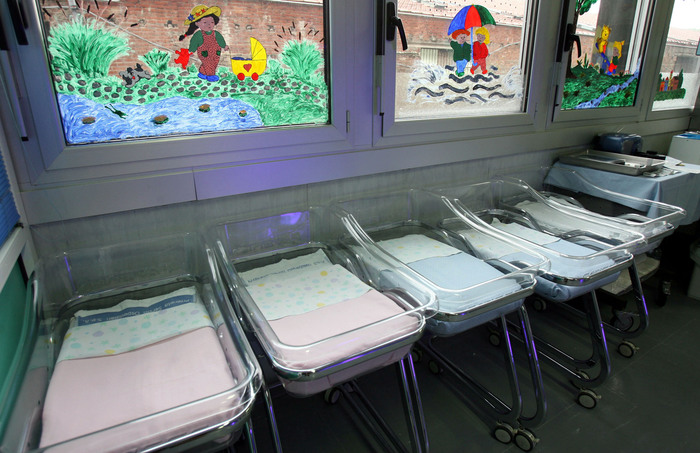The fertility rate in Europe does not stop falling.
In Italy the birth rate has reached its historic low.KIKE PARA
Fewer and fewer children are born in Italy.
This maxim has been repeated for more than a decade.
The downward trend in the birth rate has become a constant, but now the figures have reached a negative record: for the first time in the history of the transalpine country, counting since its unification 162 years ago, the number of births has fallen below 400,000 in a year.
The Italian National Statistical Institute (ISTAT) has published its latest report this Friday, with data from 2022, which shows that the demographic winter is advancing in Italy, where the birth rate has reached historic lows, with less than 7 births for every 1,000 inhabitants, while mortality remains high, with more than 12 deaths per 1,000 inhabitants.
The number of deaths almost doubled that of births last year.
In total, 713,000 people died in Italy – close to 4,000 more than the previous year – and 393,000 children came into the world, some 6,000 less than in 2021, so the natural growth rate remains negative (-320,000 people).
This is also the reason why the total Italian population has fallen again: on January 1, 2023 there were 58.8 million residents, 179,000 less (3%) than at the beginning of 2022. This collapse occurs despite of the positive migratory balance, since 229,000 more migrants arrive in Italy than leave.
In recent years there has been a notable change in demographic dynamics and since 2015, the migratory balance can no longer compensate for the negative natural balance.
Meanwhile, in the first decade of the 2000s, the natural balance between births and deaths was balanced by a positive migratory balance, mainly due to the growth of foreign residents.
The decline in the birth rate has been progressive and constant.
2008 was the last year in which there was an increase in the birth rate – compared to that year, in 2022 there were about 184,000 fewer births – and in 2015 the number of births stopped exceeding the historical threshold of 500,000.
ISTAT interprets that the low birth rate is due "only in part" to "the spontaneous or induced refusal of couples to have children", and points to the decrease in the female population of reproductive age and its progressive aging as causes of the phenomenon.
According to data from the Censis Center for Social Studies and Investments, compared to 2009, in 2019 there were 1.3 million fewer women of childbearing age (15-49 years).
The number of Italian women in this category decreased by 1.6 million, but could be offset by the increase in foreign women of the same age (300,000 more).
Once again, the decline in the immigrant population comes into play, since since 2014, the presence of foreign women of reproductive age in the transalpine country is also decreasing, which inevitably has a negative impact on the total number of births.
The Censis also attributes the drop in the birth rate to the low percentage of women working in Italy, below 60%, compared to the high figures of other neighboring countries such as Germany or Sweden, where the rate of female workers exceeds 70% and even 80%.
Experts suggest that it will take several generations to reverse the demographic decline.
The Italian Prime Minister, the far-right Giorgia Meloni, has established the Ministry of the Family, Birth and Equal Opportunities and has promised measures, which have not yet materialized, to encourage birth rates and female work.
Italy has been dragging alarming birth rates for years and has entered a transition process that is profoundly changing its demographic structure, with repercussions on society, the health system and the labor market.
The last crash in the birth rate started in 2009, although the downward trend had started earlier, with a few exceptions, but has continued without interruption year after year ever since.
Concern over the decline in the birth rate awoke in the 1970s and 1980s and it was warned then that if this rate continued, before the year 2000 it would reach zero growth and the number would begin to be higher. of deaths than that of births, something that has indeed happened.
The transalpine country has the lowest birth rate in the European Union —6.8 per 1,000 inhabitants in 2021— according to Eurostat data.
It is followed by Spain with a rate of 7.1 births per 1,000 inhabitants.
The EU average stands at 9.1 per 1,000.
Low fertility rate
The Italian fertility rate, at 1.25 children per woman, is also below the European average, which is 1.53 children per woman.
Based on this parameter, Spain has one of the lowest fertility rates in the Union, with 1.19 children per woman, behind Malta.
In the midst of this scenario, Italy has become a country that ages rapidly.
The average age of the population has gone from the beginning of 2020 to the end of 2022 from 45.7 years to 46.4.
Almost a quarter of the population, 24.1%, is over 65 years of age.
And the number of people aged 100 and over has also risen sharply, tripling in the last two decades.
In 2022 there were almost 22,000, another historical record, 2,000 more than the previous year and 15,000 more than 20 years ago.
After the strong impact of the pandemic, life expectancy has increased by a few months and stands at around 82 years.
In this context, with an increasingly aging population, environmental factors and climate change gain weight.
The highest number of deaths in 2022 occurred in the coldest months, January and December, and in the hottest, July and August.
In these four months alone, 265,000 deaths were observed, almost 40% of the total, mainly due to adverse weather conditions, which in most cases penalized the older and more fragile population, made up mainly of women.
Subscribe to continue reading
Read without limits
Keep reading
I'm already a subscriber








